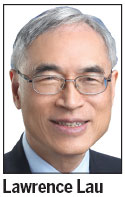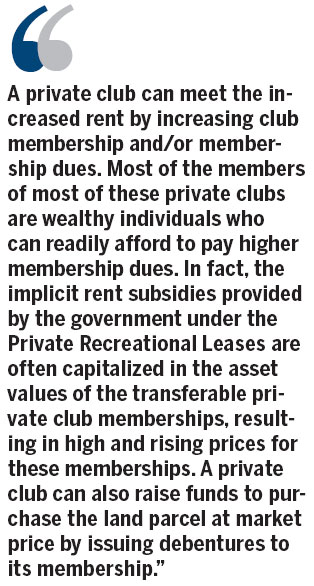On land leases and private clubs
Updated: 2013-08-20 06:35
By Lawrence Lau(HK Edition)
|
|||||||||
There is a raging controversy on the land leases of private clubs in Hong Kong today. Many private clubs in Hong Kong, such as the Hong Kong Country Club and the Hong Kong Golf Club, have obtained the use of the land parcels they occupy under "Private Recreational Leases (PRLs)" at nominal rents for specified terms. PRLs are special purpose land leases granted to private organizations that provide facilities for recreational, including sports, purposes. The rights and obligations of the holders of PRLs are set out in their respective leases. Often, the land leases provide for payment of only nominal annual lease rents that do not reflect the market values or the opportunity costs of the land parcels under lease. In most cases, the facilities constructed and maintained by the lease-holding private clubs on the leased land are for the exclusive use of their members, although there may be a requirement in the leases to allow public use under some circumstances so as to promote sports in Hong Kong. It is precisely this limited public use that is often used to justify the nominal lease rents.

Some private social and sports clubs benefited from extraordinarily low land rents dating from the colonial period. For example, the Hong Kong Club, founded in 1846, which has its premises in a prime location in Central, pays the government land rent of just HK$324 a year, under a 999-year lease signed in February 1895. Some private clubs have had their lease rents raised significantly upon the renewal of their land leases. For example, the Hong Kong Football Club, which used to pay HK$1,000 a year until December 1996, has been charged 3 percent of its rateable value per year since 1997. But other private clubs still enjoy exceptionally low rents, for example, the Hong Kong Golf Club reportedly pays only HK$1,808 a year for its 160-hectare course in Fanling.
The controversy is: On the one side, there are those who argue that the PRLs of the private clubs should not be renewed upon the expiration of their current terms; on the other side, there are those who argue that the private clubs are performing useful social functions by providing recreational and sports facilities and their PRLs should be allowed to continue. However, if the PRLs are actually charged market rents, so that no implicit government subsidies are involved, then the controversy will disappear. Moreover, with estimates of market rents, it is possible to determine the costs - the differences between the market rents of their land parcels and the actual rents paid - and to compare them with the benefits to the people of Hong Kong - e.g., public use of the facilities - to see whether the implicit government subsidies can be justified.
Privately owned land in Hong Kong, typically initially acquired from the government through the payment of a "land premium", is mostly held under government leases by which landowners have to pay an annual rent to the government in return for the right to hold and occupy the land for a specified term. Most rents, imposed under the Government Rent (Assessment and Collection) Ordinance, are 3 percent of the rateable value of the property. Rateable value is an estimate of the annual open-market rental value of the property at a designated valuation reference date, assuming that the property was then vacant and to let. Note that even a private landowner is subject to this annual rent unless the land is a freehold.
In the case of a PRL, the land is typically owned by the government. How should the market rent for the land parcel be determined? On first approximation, the rateable value of a property is a good estimate of the market rent. Thus, in principle, the market-rent-paying lessee of an unimproved government-owned land parcel should pay the government the full rateable value and not just 3 percent of the rateable value each year. However, a complication arises where there are improvements (including electrical conduits, roads, water and sewage lines, structures and landscaping) on the land parcel which have been put in and paid for by the lessee.
The rateable value will normally include the market rental values of both the land and the improvements. But a lessee of government-owned land should not have to pay rent on the improvements that the lessee itself has put in and paid for. Thus, in this case, the appropriate market rent should be limited to just the rateable value of the land parcel alone, excluding the rateable value of the improvements. The rateable value of a property should therefore be separated into two parts: the rateable value of the land alone, and the rateable value of the improvements. In fact, in many jurisdictions of the world, the valuation of a property consists of separate valuations of the land and the improvements.

The market rents thus estimated will most likely be much higher than rents currently paid by the PRLs. For example, if the improvements constitute 80 percent of the value of a property and land 20 percent, then the rateable value of land alone will be 20 percent of the full rateable value. A lease rent equal to 100 percent of the rateable value of land will be 20 percent of the full rateable value, much higher than the usual 3 percent of the full rateable value that is currently in force. In this example, in moving to market rent, the land rent will have to be increased by more than five times! However, once the land rents are set equal to market levels, there is no justification to require the lessees to make available their premises for public use. The market-rent land parcels should be treated no differently from privately-owned land parcels.
If the principle of market rent is adopted for leases on government-owned land, the implementation should be both fair and deliberate. First of all, as the Hong Kong SAR is governed by the rule of law, the terms of an existing land lease agreement should be honoured until its expiration or renewal as provided in the lease, whichever come first. But notice should be served to all holders of PRLs, that upon renewal of their leases, the terms may be changed and in particular the lease rents may be increased to market levels. Second, at renewal, an existing lessee should also be given an option to purchase the land parcel under lease from the government at market price.
A private club can meet the increased rent by increasing club membership and/or membership dues. Most of the members of most of these private clubs are wealthy individuals who can readily afford to pay higher membership dues. In fact, the implicit rent subsidies provided by the government under the PRLs are often capitalized in the asset values of the transferable private club memberships, resulting in high and rising prices for these memberships. A private club can also raise funds to purchase the land parcel at market price by issuing debentures to its membership. It can also decide not to renew the land lease at all, in which case the government can take over the operation if necessary and open the facilities to the general public.
Using the significantly enhanced stream of annual rents received from the PRLs under the market-rent regime, the government, through its Leisure and Recreation Department, can finance the construction of new recreational and sports facilities, such as football fields, swimming pools and tennis courts for the use of the general public at user fees set at marginal costs. This will make it totally unnecessary for the private clubs to allow the use of their facilities by non-members if they do not wish to do so since they will be paying market rents for their land parcels.
As to whether specific private clubs deserve the significant implicit government subsidies that they have been enjoying in terms of the below-market low rents on their leases, it will likely have to be determined on a case-by-case basis, by comparing the costs and the benefits to the people of Hong Kong. However, there must be a net benefit to the people of Hong Kong for the government subsidy to be "socially" compelling.
One issue that has not been addressed above is the possibility of change in the allowable use of a land parcel, e.g., from recreational use to residential use. The currently allowable use under a PRL may not represent the highest and best use of the land parcels, especially given that land is such an ostensibly scarce resource in Hong Kong. If there is a change in the allowable use upon renewal, say, from recreational use to residential use, then the rateable value of the land parcel should be determined with reference to the highest and best allowable use, with the market rent upon renewal based on the new rateable value of the land parcel. The lessee has the choice of renewing the lease at the new market rent and continuing with the old use (assuming that the old use is still allowable), or terminating the lease at the end of the current lease term.
The author is Ralph and Claire Landau professor of economics, at the Chinese University of Hong Kong and Kwoh-Ting Li professor in economic development, Emeritus, at Stanford University.
(HK Edition 08/20/2013 page9)